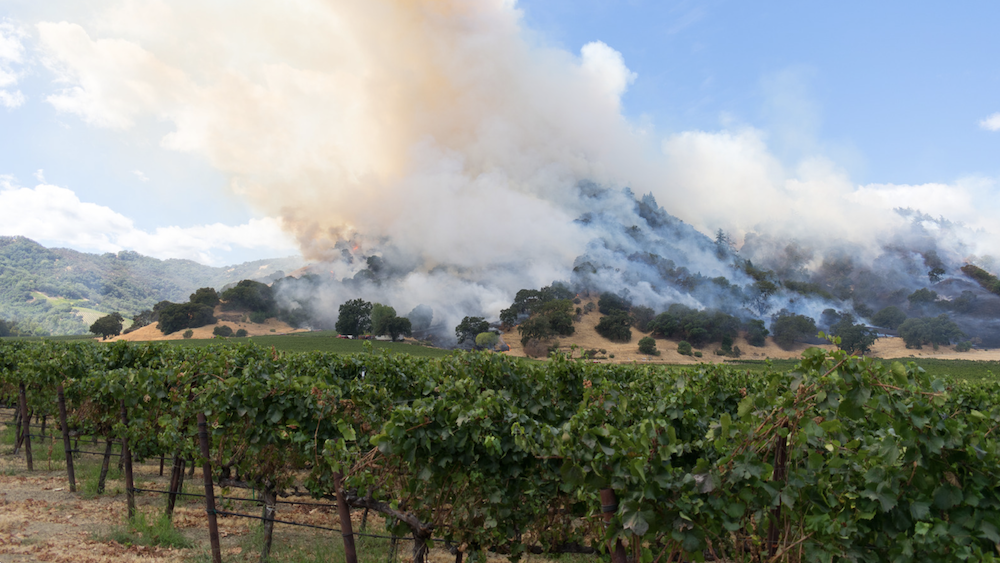
July 15, 2022 – To set the record straight, not all the wines on the market from the 2020 vintage produced on the Central Coast were smoke-tainted. While many producers decided not to make wine, there are plenty that did.
Some, like Alfaro Family Vineyards, were far enough from the fires that most of their estate wines were not impacted. They did have to forgo all the fruit they normally get from the SLH, though. A sad development, as 2020 was the last year they were set to get fruit from Garys’ and Rosella’s Vineyards. As of the last harvest season, 2021, they use all estate grown grapes.
I’ve recently tried examples of 2020 wines from several areas where fires were active, including the Santa Lucia Highlands, Arroyo Seco, Santa Cruz Mountains, Russian River Valley and Sonoma Coast. Many of them were clean and just fine. In fact, some excellent wines came out of this horrific vintage.
Chad Silacci of Rustique and Denis Hoey of Odonata, who make wine together at Odonata, admitted they had to deal with a lot of smoke taint. They declined to bottle much of what they had hoped to salvage. However, they did bottle some 2020 wines, including the 2020 Rustique Santa Lucia Highlands Chardonnay from Silacci Vineyards, which is on River Road. This wine shows lots of warm toasty oak, baked apples, pear custard, melon, lemon curd and a streak of minerality. It’s nicely rich, but deft on its feet.
From the Morgan cellar, the 2020 Tempranillo from the Riverbank Vineyard in Arroyo Seco fruit is a plush and plummy, with generous cherry and boysenberry pie a-plenty. And then there’s the leather and mocha, giving this an abundant body and so much depth. Truly a winner!
I can’t say enough about the beautiful Morgan 2020 Double L Highlands Chardonnay (13.8%). With aromas of lanolin, sheep’s cheese, lemon curd and Anjou pear, it’s complex and wonderfully expressive. In the mouth, the just ripe orchard fruit is so pretty and transparent. With very little oak, it’s the best Double L I’ve tasted in years. And that it comes from such a challenging year, is Double Lucky, indeed.
The Morgan 2020 Highlands Chardonnay shows why this wine is so popular: barrel-fermented in 29% new French oak, it’s crisp Golden apples, Asian pear and yellow peach, with a Lorna Doone shortbread cookie finish. This wine is a miracle, considering the smoke that threatened the vineyards from which the wine originated, including Double L, McIntyre, Tondre and Leavens.
Minerally, lemon fresh and laced with lime, the very low alcohol Alfaro 2020 Trout Gulch Chardonnay, 12.9%, is a truly fine example of this vineyard’s “sweet” spot, somewhere between a tropical island and a cruise down the Loire. Aromas are charming, with fresh cut pineapple, gooseberry and key lime. Not at all sweet, it’s the epitome of key lime chiffon pie, light and airy and at the same time, lemony creamy. It gets better and better with each sip, and finishes with a lurking hint of wildflower honey.
Also from Trout Gulch, the Alfaro 2020 Pinot Noir (13.5%), dances between aromas of strawberry, pine tar and pine incense, delivering up cranberry, tarragon, red plum and grilled onions on the palate. The bright acid and basil undertones keep it interesting, especially given that whisper of Rufus Teague BBQ sauce, which btw, is really excellent stuff.
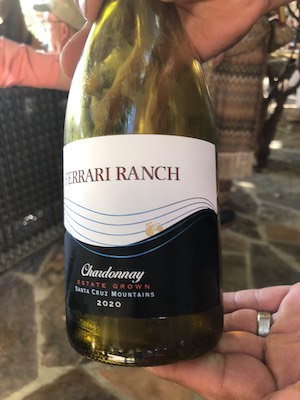
The 2020 Ferrari Ranch Chardonnay from Corralitos, tasted at a recent unveiling of new releases at the fabulous Monte Sereno home of Dave and Liz Ferrari, revealed what picking this vineyard just a little shy of the Brix of previous years, and using less new oak, can do for Santa Cruz Mountains fruit. Winemaker Ross Reedy told us they picked the day after the fire started, on August 18. They had just been through a heat wave, and then all the lightning driven fires broke out. It was a terrifying time.
The wine is slightly floral aromatically, leaning towards bright lemon, subtle peach and pretty quince on the palate, with a delicate creaminess that gives it an overall pleasing, almost elegant presence. Nothing out of balance here. In fact, winegrower and wine lover, Howard Graham, announced that 2020 Ferrari Chard was the best Santa Cruz Mountains Chardonnay he’d ever tasted. This brought quite a few gasps of surprise, coming from someone who apparently has quite the French Burgundy collection.
“To be honest, I was completely freaking out. I decided to do less oak and lots of lees stirring and just get it as creamy as possible to accentuate the texture,” Reedy told us.
They also picked the 2020 Ferrari Pinot Noir with some trepidation, but owner Dave Ferrari is a bit of a gambler. “We’d put all this effort and expense into farming, I thought, why not go out there and see if we can find any decent fruit? If it doesn’t work, we dump it, but I thought we should at least try!” And try they did.
“I was even more nervous about the Pinot than the Chardonnay, let me tell you!” Reedy admitted. “But Dave wanted to go for it and I had already refused so many contracts for VML (his day job) that I figured, why not?” So, he proceeded with caution, tossing everything that looked dicey and fermented with a bit of stems to offset what could have been slightly less than optimal ripeness. “The heat waves we had were really bad,” Ferrari told us. “And then the fires. If we made it work, at least we had something to show for a horrible year!”
The wine has persistent cranberry, bramble and ripe strawberry notes, with a slightly crunchy mid-palate, and a lingering perception of meatiness, earth and even some herbal notes, along with porcini mushrooms. It’s a testament to giving it a shot. Nothing ventured, nothing gained.
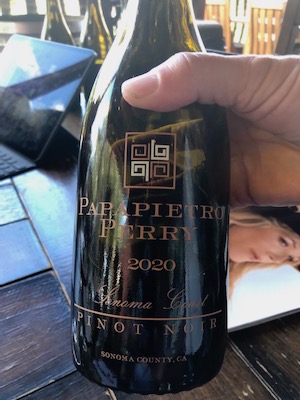
Tasting with Ben Papapietro and Renae Perry at the Pappapietro-Perry tasting room in Dry Creek Valley, was a revelation. They showed me photos of how close the 2020 LNU Complex fire had come to their tasting room facility, and to the neighboring vineyards. They have Zinfandel vines on the property but all their Pinot Noir is sourced from a series of vineyards in Russian River, Sonoma Coast and Anderson Valley, some of which they have worked with for decades now. We tasted the 2018, 2019 and 2020 versions of several wines, and remarkably, all the 2020s are solid and without any noticeable smoke impact. “We know many wineries didn’t make wine at all in 2020 for various reasons, including excess inventory,” said Papapietro. “But we were very fortunate. We jumped into action and started picking right away. Time was of the essence.”
The 2020 Sonoma Coast Pinot Noir from the Campbell, Buckner and Peters Vineyards shows similar floral notes to the 2018 and 2019 examples, along with pithy pomegranate, licorice and meat. It also displays huge acid, perhaps more obvious than in the other vintages, but that could just be its youth. It should age well.
The 2020 Laras Vineyard Pinot Noir from Russian River is what Papapietro declares “quintessential RRV.” Made of clones 115, 116, 777, Pommard and 828, it exhibits rich color, blackberry, plum, plenty of chocolate, and a deep note of cherry jam, laced with firm tannin. I actually preferred the 2020 Charles Vineyard Pinot Noir from Anderson Valley to the previous vintages. Picked a tad earlier, it is attractively floral, with crabapple, cranberry, quince and a lively, almost electric, acid that keeps it fresh. The 2020 Pommard Clone Pinot, a crowd favorite, also showssuperb color and oodles of blackberry fruit, with plush tannin, tobacco, rich chocolate and almost none of the earth of the previous vintages. This clone was a favorite of Rochioli, Williams Seylem and Swan, who all grew it back in the ‘80s.
We wrapped up with the 2020 Papapietro-Perry Zin, done in Francois Freres barrels, as are most of their wines. In this case, they were mostly 2-year used barrels. It’s wonderful, with vivid baking spices and a touch of red grapefruit along with plush red cherry. Pappapietro prefers to make Zin like a claret. This is certainly one Dry Creek Zin from 2020 you can count on. Plus the 2020 Pinots are solid.
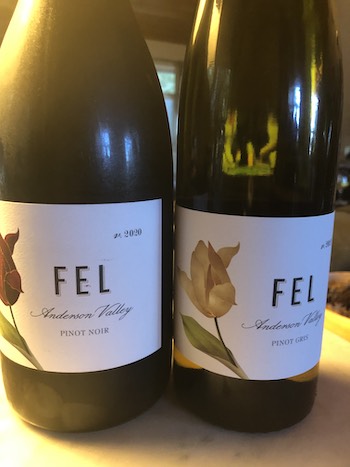
Sarah Green from FEL, which is owned by Cliff Lede, did the 2020 FEL Anderson Valley Pinot Noir (13.9%) proud, working with Ryan Hodgins, who was winemaker at the time. She became FEL winemaker in 2022. Anderson Valley was also plagued by smoke and ash during 2020. This wine shows the riper side of the region, with earth, pomegranate, red plum and just a crazy amount of cinnamon. The abundant acid takes on the intense plum, raspberry and blackberry, with a vein of porcini contributing to the overall impression of a rich and stout wine. It’s full on fleshy and ripe, more reminiscent of an RRV Pinot Noir, actually. You take what nature gives you, and you make the best of it.
Winemaker Bibiana Gonzalez Rave shows how to make Chardonnay from the Sonoma Coast: her 2020 Alma de Cattleya is as pretty as the bright floral label that adorns the bottle. This area had a huge cap hanging over it during the fires. And yet, she picked a clean batch of Chard that is redolent of gardenias, tuberose, quince, white peach and almond paste, with flavors that echo the same, adding a touch of mandarin and mango. Just gorgeous.
Winemaker, Nicole Hitchcock of J Vineyards in Sonoma, told me that it was scary dark when she drove up to Annapolis Vineyard, a Gallo property on the Sonoma Coast, to check on the grapes in August of 2020. She decided to pick them, even though a bit earlier than normal. Fortunately, she’d already completed all her picks for sparkling and Pinot Gris before the lightning maelstrom began. The 2020 J Vineyards Strata Chardonnay, a wine named for founder Judy Jordan’s love of rocks and geology, comes from Green Valley. Hitchcock ran a panel on the fruit before processing, and it looked clean, so she went for it. Done in 50% stainless steel and 50% neutral barrels, this wine is truly beautiful, with generous peach and a lovely juiciness.
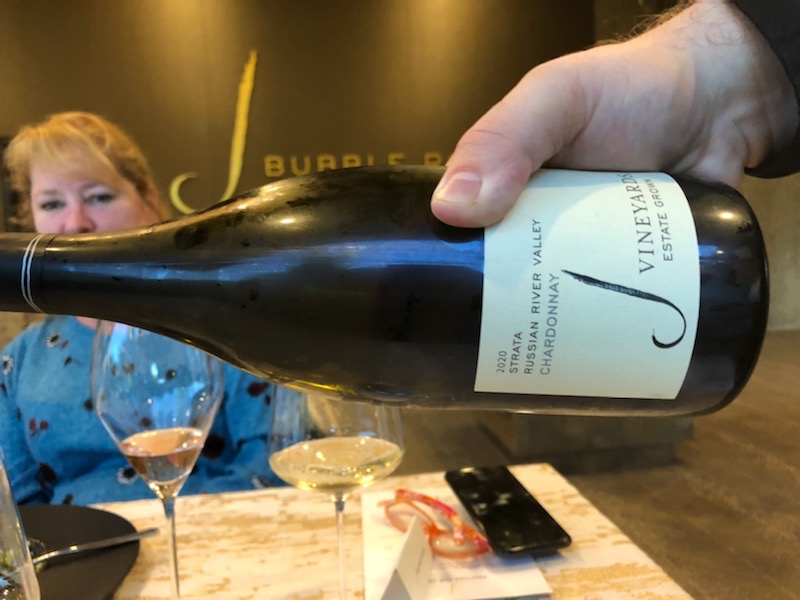
Hitchcock echoes the concerns of many winemakers who took the leap of faith and bottled wines from 2020, even when testing showed low or no smoke markers. But she isn’t fooling herself. “I know how sneaky smoke influence can be. You take all the precautions. You taste and taste with all different palates. And I’m still tasting those wines, crossing my fingers!” She acknowledges that this is a problem we are far from solving. “Even the Australians haven’t figured it out.”
About the author
Laura Ness is a longtime wine journalist, columnist and judge who contributes regularly to Edible Monterey Bay, Spirited, WineOh.Tv, Los Gatos Magazine and Wine Industry Network, and a variety of consumer publications. Her passion is telling stories about the intriguing characters who inhabit the fascinating world of wine and food.
- Laura Nesshttps://www.ediblemontereybay.com/author/lness/
- Laura Nesshttps://www.ediblemontereybay.com/author/lness/
- Laura Nesshttps://www.ediblemontereybay.com/author/lness/
- Laura Nesshttps://www.ediblemontereybay.com/author/lness/


